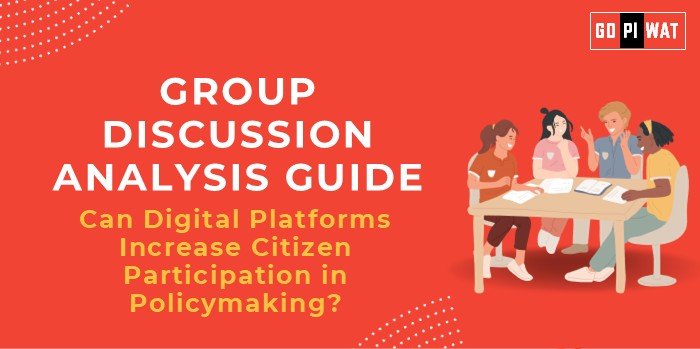📋 Group Discussion (GD) Analysis Guide
🌐 Introduction to the Topic
Opening Context: As digital platforms redefine global interactions, their potential to transform policymaking processes has garnered significant attention. Nations are exploring these tools to bridge the gap between governance and grassroots participation.
Topic Background: Digital platforms enable participatory democracy by allowing citizens to engage directly in policymaking. Initiatives like India’s MyGov and the U.K.’s e-petition platform highlight the global push toward inclusive governance. While promising, challenges such as digital literacy and data privacy persist.
📊 Quick Facts and Key Statistics
- Internet Users: 5.16 billion globally (Statista, 2024) – Indicating a vast pool for digital engagement.
- India’s MyGov Platform Users: 35 million+ (2024) – A case of successful participatory governance.
- Global E-Governance Ranking: Estonia (#1) – Leading the way in digital policymaking inclusivity (UN 2023).
- Digital Divide in India: Only 20% rural internet access – Highlighting participation limitations.
🧑🤝🧑 Stakeholders and Their Roles
- Government Agencies: Create digital platforms and ensure transparency.
- Private Tech Companies: Develop infrastructure and tools for engagement.
- Citizens: Actively provide inputs and monitor policymaking.
- Non-Governmental Organizations: Advocate for inclusive participation and bridge literacy gaps.
🏆 Achievements and Challenges
🌟 Achievements:
- Increased Policy Feedback: MyGov received over 2 million citizen responses on draft policies (2023).
- Digital Inclusion Programs: Estonia’s e-citizen initiative integrates citizens seamlessly.
- Financial Transparency: Blockchain in policymaking ensures accountability (e.g., Sweden’s land registry).
⚠️ Challenges:
- Digital Divide: Rural areas often lack access.
- Cybersecurity Risks: Data breaches undermine trust (e.g., AIIMS cyberattack, India 2022).
- Token Participation: Responses often ignored in final policymaking.
🌍 Global Comparisons and Case Studies
- Success: Estonia’s e-governance enables citizen voting online.
- Challenges: Brazil’s participatory budgeting faces issues in scaling.
- Case Study – India’s MyGov: Streamlines policy consultation but struggles with inclusivity.
- Case Study – Rajasthan’s Digital Governance: Demonstrates improved citizen engagement but limited reach.
🗣️ Structured Arguments for Discussion
- Supporting Stance: “Digital platforms foster direct democracy by enabling citizens to actively shape policies, as seen with Estonia’s e-governance model.”
- Opposing Stance: “The digital divide restricts meaningful participation, leaving marginalized communities excluded from decision-making.”
- Balanced Perspective: “While digital platforms enhance engagement, addressing infrastructure gaps and literacy is crucial for equitable participation.”
📌 Effective Discussion Approaches
- Opening Approaches:
- Statistical Lead: “With 5.16 billion internet users globally, the stage is set for participatory governance.”
- Case-Based: “Estonia’s e-voting success highlights the transformative potential of digital platforms.”
- Counter-Argument Handling:
- Acknowledge rural and cybersecurity challenges.
- Propose solutions like mobile governance (m-Gov) and blockchain.
📈 Strategic Analysis of Strengths and Weaknesses
- Strengths: Real-time feedback, cost-effective policymaking, enhanced transparency.
- Weaknesses: Cybersecurity, exclusion of digitally illiterate populations.
- Opportunities: 5G penetration, AI-driven public sentiment analysis.
- Threats: Misinformation campaigns, technological disparities.
📚 Connecting with B-School Applications
- Real-World Applications:
- Projects on e-governance integration in operations and development.
- Policy internships focusing on participatory governance tools.
- Sample Interview Questions:
- “What role can blockchain play in participatory governance?”
- “How can the digital divide be addressed in policymaking?”
- Insights for Students:
- Explore technology’s role in governance.
- Understand the ethical implications of digital tools in policy.


